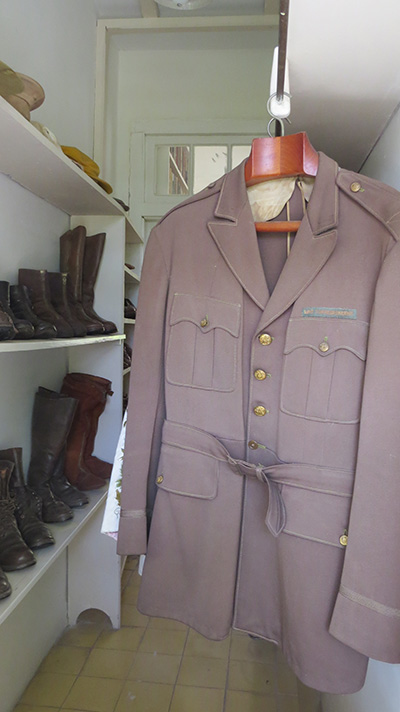Ernest Hemingway relaxing on the front veranda.
History
Organizational Background
The Finca Vigía Foundation was founded in 2002 by Jenny and Frank Phillips. Jenny was the granddaughter of Ernest Hemingway’s editor and long time friend, Maxwell Perkins.
The Phillips’ enlisted bilateral support in Congress and began the binational process to save the documents and to preserve the architecture of this historic property.
The Foundation became recognized by the IRS as a 501(c)3 tax-exempt organization in 2004, with the mission to provide the research and technical assistance necessary to restore and preserve Ernest Hemingway’s home and its contents at Finca Vigía in Cuba.
Mary-Jo Adams is the Executive Director. Stephanie Bond is the Assistant Director.

Margarita Ruiz Brandi, Former President of the Consejo Nacional de Patrimonio Cultural, with Jenny Phillips and Bob Vila, representing the Finca Vigía Foundation, sign an agreement to collaborate in the conservation of irreplaceable Hemingway documents in Cuba in 2010.
“As an archaeologist regards an undisturbed tomb, Hemingway scholars feel that
Finca Vigía is the final site for research, and the richest in Hemingway memorabilia.”
Hemingway and Cuba: Cultural Significance
American author, Ernest Hemingway, winner of the Pulitzer Prize and Nobel Prize for Literature, lived in Cuba longer than he lived anywhere else—from 1939-1960, one third of his life. His home, Finca Vigía, or Lookout Farm, was the only stable residence of his adult life. At the Finca, he wrote many of his finest works: For Whom the Bell Tolls, Across the River and Into the Trees, The Old Man and the Sea, A Moveable Feast, Islands in the Stream, and numerous short stories and articles. It is where he learned he had been awarded the 1954 Nobel Prize for Literature, and donated his gold medal to the Cuban people. Hemingway’s long and productive life in Cuba is the period that has been studied and understood the least. Hemingway once said, when asked why he lived in Cuba, that it was complicated… but “I work as well there in those cool early mornings as I ever have worked anywhere in the world.”
Finca Vigía is maintained as a historic site and scholarly research center.
Recent Work in Cuba: Overcoming Obstacles, Generating Success
In 2005 the Finca Vigía Foundation began a partnership with The National Trust for Historic Preservation. The partnership gave the Foundation access to some of the finest preservation architects, engineers, and museum curators in the United States.
Since September 2005 the Finca Vigía Foundation has sent technical teams to Cuba comprised of preservation architects, structural engineers, landscape architects, document conservators, and museum collection specialists. We have sent librarians and metadata specialists to Havana to organize Hemingway’s vast collection.
With advice from our technical teams, some preservation work on the house was completed in 2007. Hemingway’s yacht, Pilar, was also restored at that time. A preliminary assessment of the landscape was also made. In June 2008, the first phase of document conservation was completed. More than 3,000 flat documents were conserved and digitized. Images were brought to the United States, encrypted, and stored in the cloud by EMC Corporation. External hard drives containing the images were given to the John.F. Kennedy Library in Boston and the Consejo Nacional de Patrimonio Cultural in Cuba.
To date, more than 10,000 documents have been conserved or received initial stabilizing treatments. Digital images of the documents have been brought to the United States.
Most recently a Restoration Center was built on site using U.S. building materials. The Center contains wet and dry conservation laboratories and a climate controlled archival storage vault to ensure the longevity of the irreplaceable Hemingway documents. The Restoration Center is the first building constructed in Cuba, using US materials and ingenuity, since the late 1950’s.
Click here for more details about this unprecedented accomplishment.
Workforce development, mentoring, training, and workshops continue. The construction of the Restoration Center required teaching new building techniques using tools and equipment generally unknown in Cuba, establishing maintenance routines, and creating plans for emergency disaster planning.
Document conservation workshops are on-going in the new Center. New equipment in the Center including HVAC systems, an external generator, fume hoods, water tables, and drying racks also requires workforce training and maintenance planning.

The chair on the left was Hemingway’s preferred spot in the living room.
Plans for the Future
With very limited funding, and in the midst of increased threats due to severe tropical weather, this American project has flourished and continues to grow.
Our plans for the future are bold.
Saving the Cuban home of one of America’s most beloved and internationally recognized authors is an exciting and important endeavor.
As with all historic properties, constant maintenance is required. After almost 20 years, Hemingway’s home is in distress. A feasibility study conducted by US architects and engineers in December 2019 illustrated the poor condition of Finca Vigía due to water seepage and termite damage. Most importantly, the collection within the home is at risk. As a result, the Foundation has developed a preservation plan.
This architectural preservation project will be based on the knowledge and expertise resulting from the Foundation’s longstanding work at the Finca, and in particular, from the more recent successful construction of the Restoration Center. This year we hope to replace four windows that were damaged by devastating hurricanes. We also plan to conduct a Collections Assessment for Preservation (CAP) study. All to ensure the longevity of the Hemingway home and the collections within.
We are confident that together with our funders and colleagues it can be achieved.

The jacket Hemingway wore as a war correspondent.
